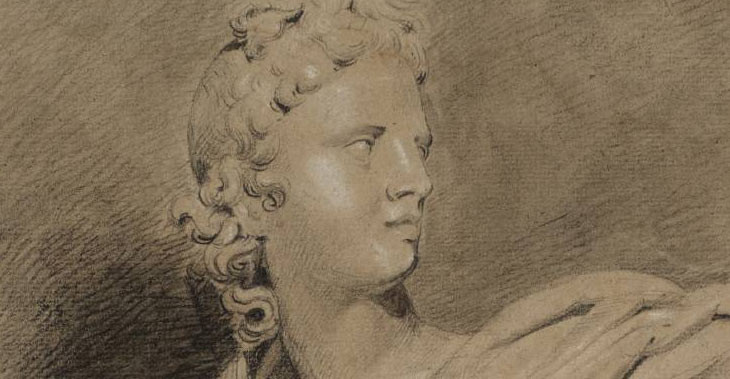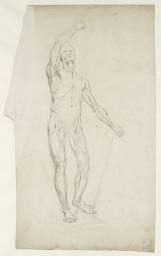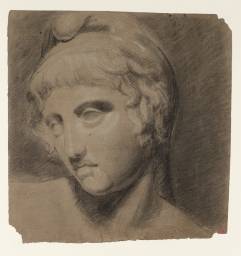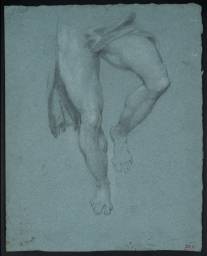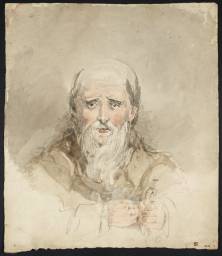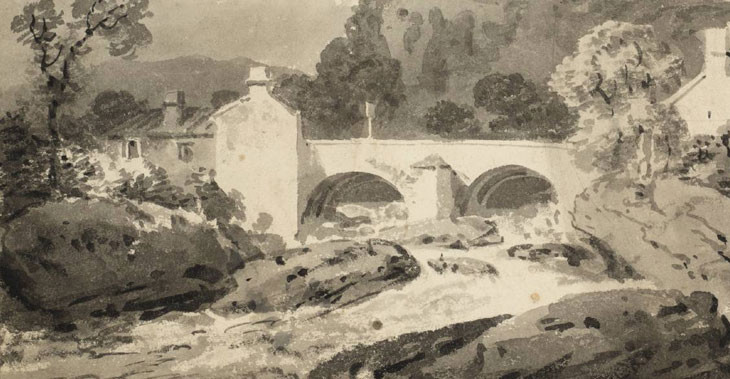Drawings Made at the Royal Academy Schools c.1789–99
From the entry
Turner entered the Royal Academy Schools, then at Somerset House on the Strand in London, in December 1789. The Schools had been an indispensable element in the Academy’s constitution from the time of its foundation under Royal patronage in 1768, and drawing both from casts of Antique and Renaissance sculptures, and from the undraped model was fundamental to the system of teaching that it promulgated: a system inherited from European Academies, most obviously in Italy and France. The drawings catalogued here are divided into subsections comprising anatomical studies, studies from the Antique, copies from other drawings and drawings from the nude model; they all appear to date from the 1790s. Some miscellaneous studies from the same period are also included. The Royal Academy did not teach painting as a separate discipline, though from the beginning the President, Sir Joshua Reynolds (1723–1792), delivered ‘Discourses’ at first annually, but after 1772 biennially, to the Academicians and students ...
D00054–D00071, D00124, D00125, D00196–D00206, D00719–D00723, D40213–D40220, D40224, D40233, D40234, D40247, D40248
Turner Bequest V A–S, X A, B, XVIII A–K, XXIX N–R
Turner Bequest V A–S, X A, B, XVIII A–K, XXIX N–R
References
Turner entered the Royal Academy Schools, then at Somerset House on the Strand in London, in December 1789. The Schools had been an indispensable element in the Academy’s constitution from the time of its foundation under Royal patronage in 1768, and drawing both from casts of Antique and Renaissance sculptures, and from the undraped model was fundamental to the system of teaching that it promulgated: a system inherited from European Academies, most obviously in Italy and France. The drawings catalogued here are divided into subsections comprising anatomical studies, studies from the Antique, copies from other drawings and drawings from the nude model; they all appear to date from the 1790s. Some miscellaneous studies from the same period are also included.
The Royal Academy did not teach painting as a separate discipline, though from the beginning the President, Sir Joshua Reynolds (1723–1792), delivered ‘Discourses’ at first annually, but after 1772 biennially, to the Academicians and students on the history of European painting. The immediate precursor of the Academy’s Schools had been the ‘St Martin’s Lane Academy’ founded by William Hogarth (1697–1764) in 1734–5, which flourished until the 1760s and has been called ‘the mother of the Royal Academy’ which ‘served as the breeding ground for that body’.1 Another precursor as a place of instruction was, from 1756, the cast collection assembled for the benefit of artists by the Duke of Richmond and housed in Richmond House in Whitehall.2 The Richmond Gallery seems to have fizzled out just as the Academy Schools began to function, though according to John Kenworthy-Browne only one of its casts was actually acquired by the Schools. A wide range of casts of ‘Greek’ and Roman statues was amplified with écorché (flayed) figures, introduced by the famous Dr William Hunter, the Academy’s first Professor of Anatomy (until 1783).
Until October 1793 Turner was allowed to sit in the ‘Plaister Academy’, drawing from casts from the Antique and from écorché figures. After 1793 he attended the ‘Life Academy’, drawing from the nude, which at that date was always male, though by the end of the decade female models were occasionally being introduced. He continued to visit the schools throughout the 1790s until awarded Associateship of the Academy in 1799, and went on availing himself of the Life Class for much of the rest of his life. As Visitor he would set the models himself. Other artist-Visitors in the Life Class over the decade covered by these drawing were:
1791: Barry, Fuseli, Northcote, West, Bacon, Banks, Zoffany, Hamilton, Russell
1792: Copley, Cosway, Opie, Rigaud, Wheatley, Barry, Fuseli, Northcote, West
1793: Bartolozzi, Burch, de Loutherbourg, Nollekens, Copley, Cosway, Opie, Rigaud, Wheatley
1794: Northcote, Fuseli, Whetley, Rigaud, Bacon, Banks, Hamilton, Smirke, Barry
1795: Northcote, Fuseli, Wheatley, Rigaud, Bacon, Banks, Hamilton, Smirke, Barry
1796: Burch, Hoppner, Lawrence, Stothard, Westall, Northcote, Fuseli, Wheatley, Rigaud
1797: Banks, Hamilton, Nollekens, Smirke, Burch, Hoppner, Lawrence, Stothard, Westall
1798: Barry, Fuseli, Northcote, Opie, Rigaud, Banks, Hamilton, Nollekens, Smirke
1799: Beechey, Burch, Hoppner, Stothard, Barry, Fuseli, Norhcote, Opie, Rigaud
1800: Banks, Hamilton, Bartolozzi, Nollekens, Smirke, Beechey, Burch, Hoppner, Stothard
As Finberg noted, Turner bought six Academy studies by John Hoppner (1758–1810) in Dr Thomas Monro’s sale, 27 June 1833 (123); he acquired others by Charles Reuben Ryley (c.1752–1798) at that artist’s sale, Christie’s, 15 November 1798 (20, 27, 56).3 There is therefore evidence that works of this kind by both artists remained in Turner’s studio, and Finberg adduced this to support his doubts as to the authenticity of many of the Academy studies in the Bequest – doubts shared by at least one of Turner’s executors, George Jones. However, those catalogued here are stylistically coherent and consistent with similar studies in other parts of the Bequest, especially in the Calais Pier sketchbook (Tate; Turner Bequest LXXXI).
A few Academy studies are in collections elsewhere: two in the Victoria and Albert Museum, London, and one in a private collection. The Art Institute of Chicago possesses a ‘five-point’ study of a man kneeling on one knee (Leonora Gurley Memorial Collection, 1922.1479), an exercise of the kind favoured by Henry Fuseli (1741–1825), Professor of Painting at the Royal Academy 1799–1805 and 1818–25, and Keeper 1804–25. Turner’s drawing seems to date from about 1798.4 The author is grateful to Annette Wickham for pointing out similarities between Turner’s studies and those of other artists attending the Academy’s Schools in the 1790s and early 1800s.
Technical notes:
As well as occasional offsets between the drawings in this group produced by the flood at the Tate Gallery in 1928, mentioned in individual entries, there are separately accessioned offset sheets relating to the following:
| Tate Turner drawing | Turner Bequest | Tate offset sheet | numbered |
| D00056 | V C | D40539 | ‘19’ |
| D00060 | V G | D40541 | ‘21’ |
| D00069 | V Q | D40540 | ‘20’ |
| D00197 | XVIII B | D40545 | ‘25’ |
| D00198 | XVIII C | D40544 | ‘24’ |
| D00200 | XVIII E | D40537 | ‘17’ |
| D00201 | XVIII F | D40543 | ‘23’ |
| D00202 | XVIII G | D40542 | ‘22’ |
| D40234 | XVIII G [verso] | D40531 | ‘11’ |
| D00203 | XVIII H | D40532 | ‘12’ |
| D00204 | XVIII I | D40538 | ‘18’ |
| D00206 | XVIII K | D40536 | ‘16’ |
How to cite
Andrew Wilton, ‘Drawings Made at the Royal Academy Schools c.1789–99’, April 2012, in David Blayney Brown (ed.), J.M.W. Turner: Sketchbooks, Drawings and Watercolours, Tate Research Publication, December 2012, https://www

